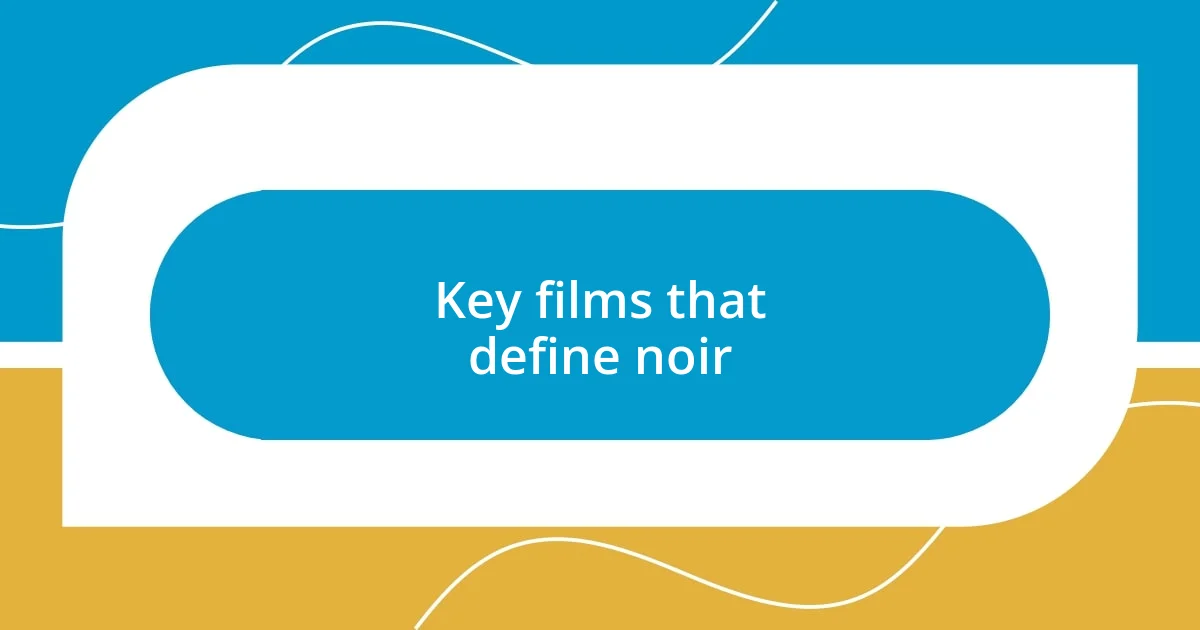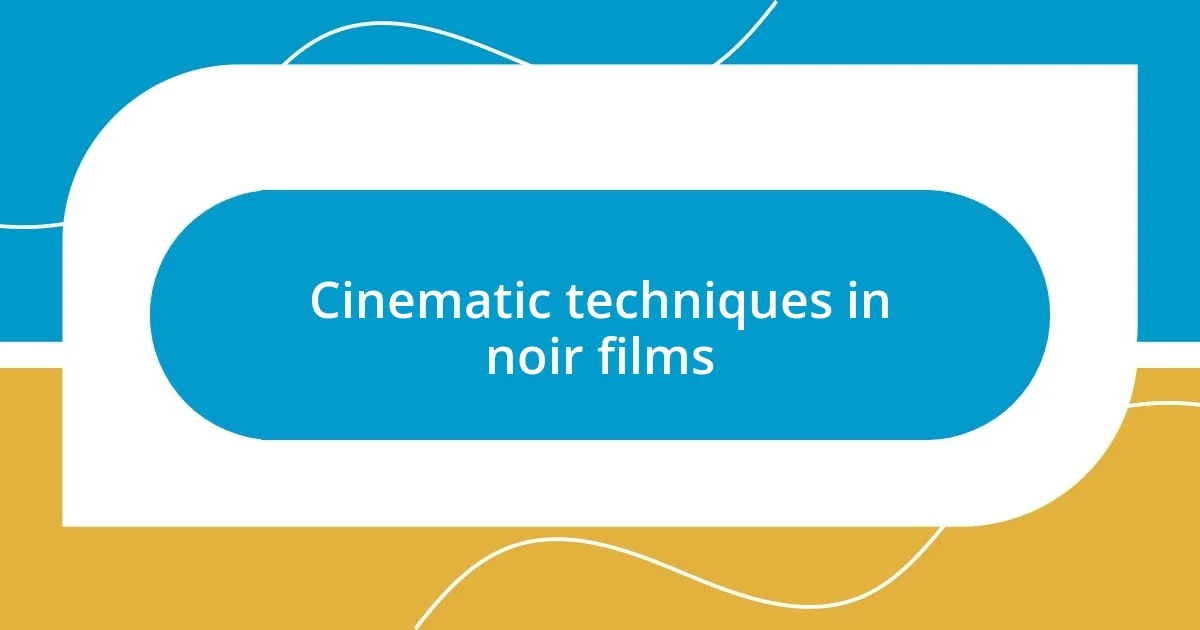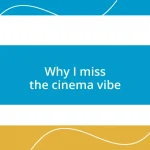Key takeaways:
- Film noir is characterized by stark contrasts, moral ambiguity, and complex characters, showcased through evocative lighting and sharp dialogue.
- Key films like “The Big Sleep,” “Sunset Boulevard,” and “Laura” illustrate the genre’s rich narrative styles and themes of obsession, fame, and the essence of love.
- Influential directors such as Billy Wilder, Alfred Hitchcock, and Howard Hawks shaped noir’s distinctive visual and storytelling techniques, inviting deeper reflections on human nature and moral dilemmas.

Understanding film noir characteristics
Film noir at its core is defined by its stark contrasts and moral ambiguity. The lighting plays a crucial role—those shadowy streets and dimly lit interiors create an atmosphere of danger and intrigue. I remember the first time I saw “Double Indemnity”; the way Barbara Stanwyck moved in and out of the shadows felt like she was a character caught in a web of deceit, and I couldn’t help but wonder: what truths lie beneath such alluring facades?
Another hallmark of noir is its complex characters, often caught in desperate situations. The anti-hero archetype, with their flawed motivations and ambiguous morals, really strikes a chord with me. I think of the gritty charm of Humphrey Bogart in “The Maltese Falcon.” His character oozes cynicism but also a surprising vulnerability. Doesn’t it make you reflect on the grey areas of right and wrong in our own lives?
The dialogue in these films is just as compelling as the visuals. Quick-witted exchanges and hard-boiled lines create a rhythm that pulls you in, making you feel like you’re part of the underbelly of society. I remember hanging onto every word of “Chinatown”; it’s astonishing how a single line can encapsulate despair and tenacity. Doesn’t it make you appreciate the power of words and storytelling in revealing deeper truths?

Key films that define noir
The world of film noir is rich with movies that have shaped the genre. One standout is “The Big Sleep.” From the moment Humphrey Bogart’s Philip Marlowe enters the scene, you sense the tension in the air. I recall the first time I saw it; I was captivated by the labyrinthine plot and the enigmatic allure of Lauren Bacall. Each twist kept me riveted, making me question who could be trusted in a murky world where nothing is as it seems.
Another essential film is “Sunset Boulevard.” The haunting narrative and the complex relationship between the fading star Norma Desmond and the struggling screenwriter Joe Gillis resonated with me deeply. The eerie exploration of fame and obsession drew me in, as I found myself reflecting on society’s relentless pursuit of youth and success. How many of us have felt entangled in our ambitions, much like Joe did?
Lastly, “Laura” offers a mesmerizing blend of romance and mystery, making it a cornerstone of noir. The way the character Laura Hunt is woven into the narrative—existing in memory and desire—makes me ponder the true essence of love and loss. I vividly remember the atmosphere of suspense that held my attention, as the mystery unfolded like a delicate flower revealing its secrets. Isn’t it fascinating how these films manage to conjure such profound emotions through their striking visuals and engaging stories?
| Film | Director |
|---|---|
| The Big Sleep | Howard Hawks |
| Sunset Boulevard | Billy Wilder |
| Laura | Otto Preminger |

Influential directors of film noir
Certainly! Here’s a focused exploration on the influential directors of film noir, enhanced with personal reflections and insights.
Many directors left a profound imprint on film noir, shaping its distinctive style and themes. One director who stands out to me is Billy Wilder. His film “Double Indemnity” showcases a masterclass in blending suspense with sharp dialogue. I recall feeling an unsettling thrill as the characters plotted their dark course; Wilder had a way of pulling back the curtain on human greed in a manner that felt both deliciously enticing and chilling.
- Alfred Hitchcock: Often considered the master of suspense, his influence on noir is undeniable with films like “Shadow of a Doubt.”
- Howard Hawks: Known for his collaborative approach, his work on “The Big Sleep” forged a compelling narrative rich in character complexity.
- Jacques Tourneur: His expressionistic work in “Out of the Past” captivates the viewer with its haunting visuals and themes of inevitability.
Seeing how these directors navigated the intricate dance of light and shadow ignites my appreciation for their artistry. Each filmmaker brought their unique vision, challenging conventional storytelling and inviting audiences to ponder the moral dilemmas faced by their characters.

Cinematic techniques in noir films
The cinematic techniques employed in noir films truly set them apart, drawing viewers into a shadowy world rife with intrigue. One of the most striking features is the use of chiaroscuro lighting, creating deep contrasts between light and shadow. I remember watching “The Maltese Falcon” and how the interplay of shadows enveloped the characters, mirroring their moral ambiguity. It made me wonder: how can light and darkness so profoundly influence a story’s tone?
Another hallmark of noir is its distinctive camera angles and framing. Low angles often emphasize the towering presence of characters, making their intentions seem both grand and ominous. I recall feeling a sense of dread as I experienced this technique in “Touch of Evil.” It’s fascinating how these visual choices can evoke such powerful emotions and set the stage for tension. Have you ever noticed how a simple tilt of the camera can dramatically shift the narrative’s dynamic?
Equally compelling is the use of voiceover narration, which provides a glimpse into the protagonist’s psyche. Films like “Out of the Past” utilize this technique masterfully, allowing us to hear the haunting thoughts of characters who are trapped by fate. When I first encountered the melancholic musings of Jeff Markham, I found myself reflecting on fate’s grip on my life too. Isn’t it intriguing how such personal insights can resonate deeply with our own experiences?

Personal reflections on film noir
Reflecting on film noir often takes me back to a time when I first discovered its mesmerizing world. I can still recall the sudden rush of excitement while watching “Double Indemnity.” The femme fatale character, Phyllis Dietrichson, was unlike anyone I had encountered before. Her mix of charm and danger had me questioning the limits of morality. How fascinating it is that a film can hold such a mirror to our deepest fears and desires, making us reconsider our own choices?
There’s something uniquely alluring about the bleak landscapes and gritty narratives that define film noir. I vividly remember one late night at home when I decided to watch “Chinatown.” The film’s darker themes and intricate plot twists left me feeling as if I was unraveling a mystery within myself. It’s intriguing how these stories often challenge us to confront the uncomfortable realities of life. Do you find that certain films resonate with your own experiences, forcing you to reflect on your path?
What strikes me as most profound is how film noir encapsulates the complexities of human relationships under pressure. Watching “The Big Sleep” for the first time, I was drawn to the chaotic yet gripping dynamic between Philip Marlowe and the Sternwood sisters. It made me ponder the layers of trust and betrayal in my own relationships. Isn’t it amazing how these cinematic portrayals can reflect our real-world struggles and triumphs, creating a space for empathy and understanding?














